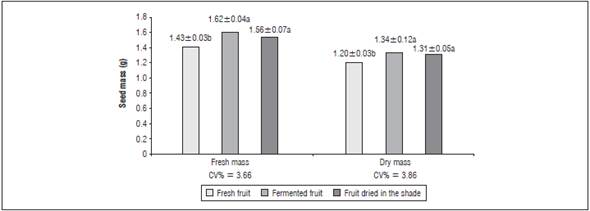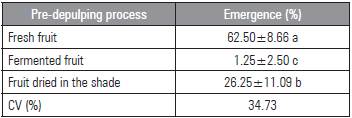INTRODUCTION
The queen palm (Syagrus romanzoffiana [Cham.] Glassman), also known as jerivá, baba-de-boi and pindó, is a native palm of South America, distributed in Brazil, Paraguay, Argentina and Uruguay. In Brazil, this species is found from southern Bahia to the Rio Grande do Sul State in several forest habitats, including in dry areas (Falasca et al., 2012; Lorenzi et al., 2015; Santos and Salomão, 2017; Bruno et al., 2019).
The S. romanzoffiana palm is widely cultivated for ornamental purposes because of its beauty and low maintenance (Downer and Hodel, 2001; Zimmermann et al., 2011; Santos and Salomão, 2017). It has high fruit production that stands out because of its importance as a natural food source for several wild species of birds and frugivorous mammals during periods of food shortages (Silva et al., 2011; Begnini et al., 2013). The fruits are globous, smooth, with a yellow or orange epicarp, and a yellow pulp (meso-carp). They are fleshy-fibrous, sweet flavored, can be consumed in natura in the form of juices and the pulp oil serves as a vitamin A source because of the contents carotenoids and tocopherols (Messias and Alves, 2009; Goudel, 2012; Coimbra and Jorge, 2012; Lorenzi et al., 2015; Santos and Salomão, 2017). It presents a single seed per fruit, protected by a woody endocarp, measuring about 2.4 by 1.6 cm. The seed contains high levels of lipids (more than 50%), making it possible to obtain biodiesel (Vallilo et al., 2001; Goudel et al., 2013; Moreira et al., 2013).
The propagation of Arecaceae plants, such as S. romanzoffiana, is done sexually with seeds, which makes the process of obtaining new plants slow and difficult, especially on large scales (Zimmermann et al., 2011; Oliveira, 2014; Lorenzi et al., 2015; Santos and Salomão, 2017). In addition, seed germination is slow, uneven and susceptible to degradation and loss of vigor as a result of embryo deterioration, even under laboratory conditions, possibly because of the crystallization of endosperm lipids (Dewir et al., 2011; Goudel et al. 2013; Oliveira et al. 2015; Silva-Cardoso et al., 2017).
The queen palm seed is small and connected to the endocarp with a recess, thus forming the pyrene. Separation without damage to the seed is practically impossible, so it is common for the whole pyrene to be used for S. romanzoffiana propagation (Goudel et al., 2013; Garcia, 2015). Numerous studies with palm seeds recommend before the pyrenes planting use some kind of pulp removal (depulping), either manually (Matteucci, 2007; Dias et al., 2011; Goudel, 2012; Pinheiro et al., 2017; Pernús and Sánchez, 2017; Beltrame et al., 2019), scraping with the aid of sieves (Dewir et al., 2011; Garcia, 2015; Isoschi et al., 2016; Félix et al., 2017; Munhoz et al., 2017) or mechanically with the aid of pulpers (Oliveira, 2014). The aim of depulping is to reduce the incidence of fungi and bacteria that use the fruit pulp (mesocarp + epi-carp) as a substrate for its development and end up reducing the germinative embryo potential (Bovi and Bortoletto, 1998); however, there is no methodology specific to the queen palm.
Because of the lack of information on efficient methods of depulping queen palm fruits, the present study aimed to establish a depulping methodology that is less aggressive to the embryo of this species, maintaining emergence quality.
MATERIAL AND METHODS
This experiment was carried out in the Laboratory of the Horticulture Sector of the Federal University of Goiás, in Goiânia-GO, in 2017. The fruits used in the experiment were from eight stock plants of the queen palm (Syagrus romanzoffiana [Cham.] Glassman), 11 years old, located on private property in the municipality of Anápolis-GO. The experiment design was completely randomized in a 2x3 factorial scheme (depulping methods'seed lots: pre-depulping). Four replicates were used, 25 seeds per plot.
Bunches were collected with fruits in stage IV maturation (completely orange fruit), according to the maturity point defined by Garcia (2015). The fruits were then separated into three lots: in the first, the fruits were depulped soon after harvesting the bunches containing fresh fruits. In the second batch, the fruits were kept in a shaded place at room temperature for 7 d (dry in the shade). In the third batch, fruits were placed in a container with water for fermentation in a shaded place, also for 7 d (fermented fruit).
After the pre-depulping treatments, the fruits were submitted to two depulping methods: one used a mechanical pulper, and the second used a concretemixer with gravel (gravel number 2: between 2 and 64 mm). An industrial pulper (Bonina 0.25 DF model, Itametal, Brazil) equipped with a sieve with 0.8 mm diameter holes and a concrete-mixer (MAQTRON-M400 model, Joaçaba, Brazil) with a 1.5 kW power engine and 400 L capacity were used.
After the pulp extraction, the material was allowed to dry in a shaded and ventilated place for 4 d. Subsequently, the pulp and remaining fibers were manually separated from the pyrenes (seeds with endocarp attached) with the aid of knives. The pyrenes and fibers were placed in a greenhouse with forced air circulation for 24 h at 65 °C to dry. Afterwards, the material was weighed to determine the remaining dry mass that was adhered to the pyrene in each treatment.
To determine the effect of the pre-depulping treatment on seed germination, samples containing 25 seeds per replicate were prepared in plastic perforated trays using medium sand sterilized in an autoclave for 1 h at 121°C and 1 atm pressure, which were kept in a greenhouse. The sand was moistened with the amount of water equivalent to 60% of the retention capacity at planting time.
After 330 d, the emerged seedlings that reached adequate transplant size (25 cm) were quantified. The data were submitted to analysis of variance, and the means were compared by the Tukey test at 5% probability.
RESULTS AND DISCUSSION
The pulp and fiber removal from the pulper was significantly more efficient than the concrete mixer, with the fresh fruit being the most difficult to depulp with the concrete mixer (Tab. 1).
Table 1 Fresh mass (FM) and dry mass (DM) of fibers remaining on queen palm pyrene at different pre-sowing and depulping processes.

The depulping objective is to remove the maximum amount of the pulp adhered to the pyrene to reduce possible attack by contaminants and predators on the seed since the average pulp percentage in queen palm fruits corresponds to about 60% of the total fruit weight and has around 65% moisture (Goudel et al., 2013), providing a food substrate for these organisms. Although the remaining fibers in the fruits were greater in the treatments with the concrete mixer, Oliveira (2014) found that there was no increase in germination with the pore fiber removal since these fibers do not restrict water absorption in queen palm seeds. In addition, the endocarp itself is permeable to water, allowing seeds to acquire or lose moisture within the structure (Baskin and Baskin, 2014; Oliveira et al., 2015; Santos and Salomão, 2017) and offering a physical defense from attack by small rodents (Guimarães et al., 2005). For other Arecaceae (Sabal palmetto e Thrinax morrisii), the fruit pericarp (epicarp, mesocarp and endocarp) presents a certain impermeability to water and, possibly, to oxygen, a limiting factor for seed germination (Dewir et al., 2011), making the removal of these impediment layers via depulping and scarification important.
There was no significant interaction for the mass of the pyrenes for the depulping method used, only for the pre-treatment. For the fresh fruits, lower values were observed for the pyrene fresh mass and dry mass than in the fermented fruits and fruits dried in the shade (Fig. 1). Several authors have indicated that the mean values of queen palm pyrenes dry mass vary from 1.21 to 2.40 g (Goudel, 2013; Fleury et al., 2015; Garcia, 2015). In the present study, the average dry mass was 1.28 g although the values of the coefficient of variation (CV) were relatively low, indicating high sample homogeneity. Variation in several characteristics is normal in palms of the same species as a result of environmental factors and genetic variability (Batista et al., 2011a; Mhanhmad et al., 2011).

Figure 1 Fresh and dry mass of queen palm pyrenes after different pre-sowing processes. CV = Coefficient of variation; ± = standard error.
Fruits used in the experiment had an average moisture content of about 62.6%, and the pulp was responsible for 60% of the total moisture content of the fruits. A study on S. romanzoffiana showed that the pulp corresponds to about 60% of the total fruit weight and has 66.83% of the moisture (Goudel et al., 2013). The high moisture content can cause undesirable changes in the physical, chemical and organoleptic characteristics of fruits and seeds (Moura et al., 2010), meaning depulping presents advantage as a seed preservation mechanism. For Euterpe espiritosantensis, the presence of pulp impairs final seed quality during storage (Martins et al., 2000)
For S. romanzoffiana, the highest plant emergence was observed for fresh fruits depulped and immediately sown (62.50%) (Tab. 2). In the non-depulped pyrene, germination was about 35% (Goudel et al., 2013). The seeds of freshly harvested ripe queen palm fruits (completely orange) germinate better than stored seeds (Oliveira, 2014), reaching up to 91.25% germination (Garcia, 2015). For Syagrus oleracea, the germination rate ranges from 50% to 65% (Diniz and Sá, 1995; Batista et al., 2011b). The Euterpe precatoria (Arecaceae) fruits sown immediately after harvesting showed the highest germination percentage (Costa et al., 2018). The great variability found in the literature was attributed to the fact that the plant is semi-domesticated, with little selection and improvement (Nascente and Peixoto, 2000).
It was observed that fruits dried in a shaded environment presented a low emergence rate when compared to the fresh fruits but were still higher than the fruits with fermented pulp (Tab. 2). The queen palm seed has low longevity and undefined storage behavior (Santos and Salomão, 2017); however, Goudel et al. (2013) did not observe negative effects on the viability and vigor of queen palm seedlings, suggesting a certain tolerance to seed water loss.
The pulp fermentation exerted a negative influence on the seedling emergence. The decrease in germination can be attributed to increased susceptibility to deterioration (Oliveira, 2014), possibly because of the increased humidity. For Archontophoenix alexandrae, fruit depulping after immersion in water for three days provided the highest germination index of freshly harvested seeds, without resulting in large losses in viability (Teixeira et al., 2011). Seed scarificationand water immersion over a period of time is efficient at overcoming dormancy and increasing germination rates in Arecaceae (Moussa et al., 1998; Dewir et al., 2011). It is believed that the fruit immersion for seven days in water caused embryo death, possibly by anaerobiosis, cotyledon fermentation or even temperature increases, as a result of fermentation.
CONCLUSIONS
The electric pulper was more efficient for the removal of pulp and pulp fibers than the concrete mixer, with fresh fruits being the most difficult to pulp with the concrete mixer. However, the depulping method did not significantly affect the mass of the pyrenes. Lower values of fresh mass and dry mass of the pyrene were observed in the fresh fruits than in the fermented fruits and fruits dried in the shade. This fermentation and partial pulp dehydration exerted a negative influence on seedling emergence, different from what was obtained with the use of fresh fruits that were sown immediately, which promoted a higher emergence rate.




![Growth and quality of lisianthus [Eustoma grandiflorum (Shinn.)] cultivated in rice husk substrates in troughs with leaching recirculation](/img/en/prev.gif)











